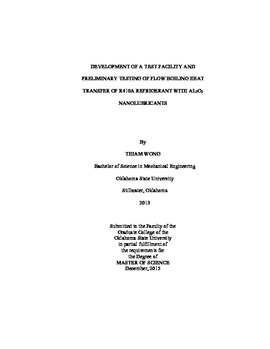| dc.contributor.advisor | Cremaschi, Lorenzo | |
| dc.contributor.author | Wong, Thiam | |
| dc.date.accessioned | 2017-02-22T22:13:18Z | |
| dc.date.available | 2017-02-22T22:13:18Z | |
| dc.date.issued | 2015-12-01 | |
| dc.identifier.uri | https://hdl.handle.net/11244/49024 | |
| dc.description.abstract | In vapor compression cycles, a small portion of the oil circulates with the refrigerant throughout the system components, while most of the oil stays in the compressors. In heat exchangers, the lubricant in excess penalizes the heat transfer and increases the pressure losses: both effects are highly undesired but yet unavoidable. Nanoparticles dispersed in the excess lubricant are expected to provide enhancements in heat transfer. While solubility and miscibility of refrigerants in polyolesters (POE) lubricant are well established knowledge, there is a lack of information regarding if and how nanoparticles dispersed in the lubricant affect these properties. This thesis presents experimental data of solubility of two types of Al2O3 nanolubricants with refrigerant R-410A. The nanoparticles were dispersed in POE lubricant by using different surfactants and dispersion methods. The nanolubricants appeared to have slightly lower solubility than that of R-410A but actually the solid nanoparticles did not really interfere with the POE oil solubility characteristics. A test facility and experimental methodology was developed for the investigation of heat transfer coefficient and pressure drop. The pressure drop of the refrigerant lubricant mixtures during flow boiling depended on the mass flux of the refrigerant. Greater augmentation was seen in the pressure drop results with decreasing mass flow rate. Pure refrigerant R410A showed the lowest pressure drop, addition of nanolubricants to the refrigerant showed a slightly higher pressure drop and POE-refrigerant mixture showed the highest pressure drop in the tests conducted. Enhancement or degradation in heat transfer coefficient during flow boiling depended on the nanoparticle concentration in the lubricant as well as the lubricant concentration in refrigerant. R410A showed the highest heat transfer coefficient for all conditions tested. For a concentration of 1% nanolubricant in refrigerant, the heat transfer coefficient showed more enhancement with increase in nanoparticle concentration compared to POE refrigerant mixtures. For a concentration of 3% nanolubricant in refrigerant mixtures there was little to no enhancement for tests conducted. | |
| dc.format | application/pdf | |
| dc.language | en_US | |
| dc.rights | Copyright is held by the author who has granted the Oklahoma State University Library the non-exclusive right to share this material in its institutional repository. Contact Digital Library Services at lib-dls@okstate.edu or 405-744-9161 for the permission policy on the use, reproduction or distribution of this material. | |
| dc.title | Development of a Test Facility and Preliminary Testing of Flow Boiling Heat Transfer of R410a Refrigerant with Al2o3 Nanolubricants | |
| dc.contributor.committeeMember | Bach, Christian | |
| dc.contributor.committeeMember | Santhanakrishnan, Arvind | |
| osu.filename | Wong_okstate_0664M_14445.pdf | |
| osu.accesstype | Open Access | |
| dc.description.department | Mechanical & Aerospace Engineering | |
| dc.type.genre | Thesis | |
| dc.type.material | text | |
